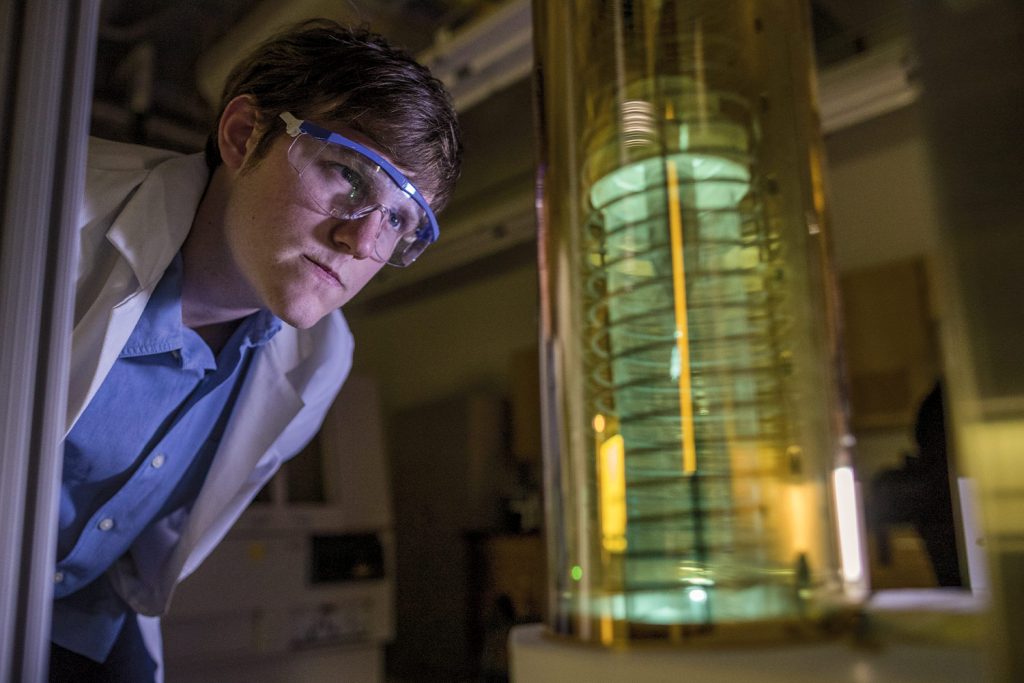Siemens, SMRC Continue Crystal-Clear Vision for Growth
Radiation is something you can’t see, touch, or smell, but need to be able to detect. Scintillators are materials that give off photons of visible light when exposed to ionizing radiation, making it possible to detect, and making scintillators very useful across a wide variety of fields.
At UT, the Scintillation Materials Research Center (SMRC) has been on the cutting edge of research and development of such materials for many years and has become internationally known for its discoveries of novel scintillators in the form of single crystals, thin films, and polycrystalline ceramics.
SMRC’s origins date back to CTI Molecular Imaging, a company founded by UT engineering graduates that was a leading provider of PET and CT scanners for medical use. Siemens Medical Imaging bought CTI in 2005 and, in a joint partnership with UT, created SMRC.
Since its creation, Siemens has provided SMRC more than $7 million in funding as well as in-kind gifts of technology and software. More than 20 graduate students and over 40 undergraduates have benefitted from research experiences and positions with SMRC made possible in part by Siemens’ investment.
Scintillators are critical to PET and CT scanner technology, according to SMRC Director Chuck Melcher, who also holds research faculty appointments in the Departments of Materials Science and Engineering and Nuclear Engineering.
“PET and CT scanners only perform as well as the scintillators within them,” Melcher explained. “So, continuing to improve upon them is a key development for patients around the world.”
In addition to the technological benefits to Siemens and the medical imaging community, the partnership has focused heavily on student success. Numerous engineering students have graduated with valuable skills gained from their experience working at SMRC.
Harold Rothfuss (PhD/MSE, ’13), now a key scientist at Siemens, took part in several research breakthroughs related to cooping, or fine-tuning, in a sense, of crystals while working with the SMRC.
Former graduate research assistant Camera Foster (PhD/MSE, ’19), also worked with Siemens as part of her research into scintillation and luminescence while at UT.
“Working closely with Siemens taught me a great deal about the scintillator field,” she said. “It was unique because it highlighted the benefits of research on a university level as well as how that research directly impacts industry.”
Matthias Schmand, vice president of research and development at Siemens, served on Foster’s dissertation committee.
A new development at UT has further strengthened the connections between SMRC and the medical field with the launch of the Department of Nuclear Engineering’s medical physics program. Everett Cavanaugh, a master’s student supported by Siemens working in the SMRC, is part of the program’s inaugural class.
“We’re obviously proud of the contribution we can make on the education side, and Siemens has been a steadfast supporter of both education and research,” said Melcher. “It has been an extraordinarily successful partnership.”
If past success is any indication, the future potential of the Siemens-UT partnership seems crystal clear.
A Crystal Anniversary
Now, in its 15th “crystal anniversary” year, the center shows no signs of slowing down. SMRC and its researchers have recently won several awards and gained recognition from the scientific community:
- Assistant Professor Mariya Zhuravleva (MSE) was the recipient of a 2019 NSF Early CAREER Award
- Graduate student Daniel Rutstrom (NE) won a Nuclear Energy University Program Graduate Fellowship in 2019 and a 2020 Innovations in Nuclear Technology R&D Award, both from the US Department of Energy
- Undergraduate student Ian Greeley (MSE) was named a 2019 Goldwater Scholar, among the most prestigious undergraduate STEM scholarships in the US
- Assistant Research Professor Yuntao “Jeffery” Wu (MSE) received a prestigious IEEE 2017 Radiation Instrumentation Early Career Award
- Professor Melcher (MSE) was elected to the IEEE NPSS Nuclear Medical Imaging Steering Committee in 2018
- Zhuravleva and Research Associate Merry Koschan (SMRC) were elected as president and secretary, respectively, to the American Association for Crystal Growth
- SMRC faculty and staff have been invited to speak at conferences across the globe, including in Japan, Germany, and India.
